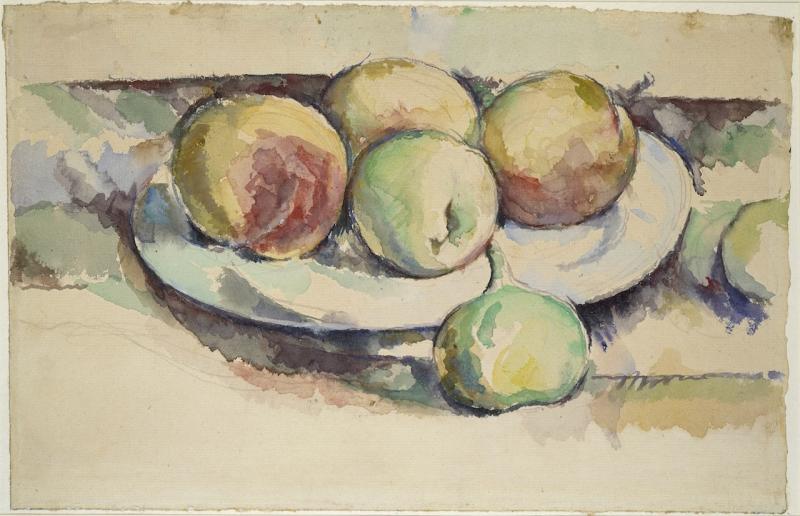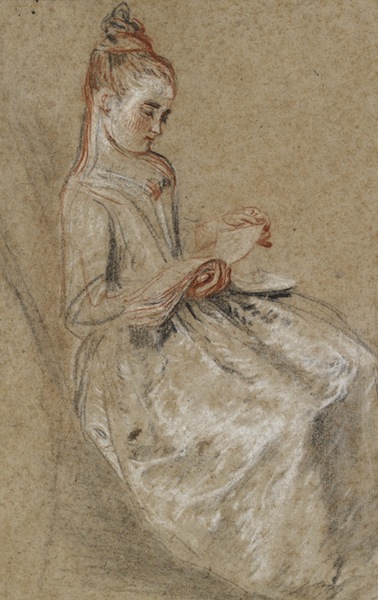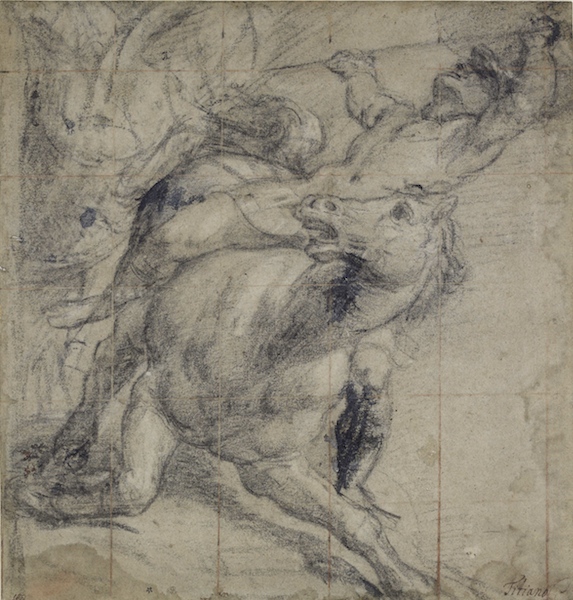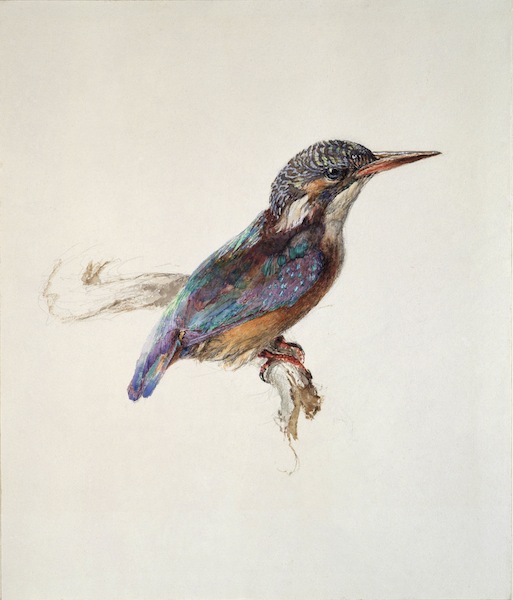Master Drawings, Ashmolean Museum, Oxford | reviews, news & interviews
Master Drawings, Ashmolean Museum, Oxford
Master Drawings, Ashmolean Museum, Oxford
An unusually intriguing survey of what drawing has meant in the history of western art

Michelangelo evidently regarded drawing as the foundation of not only painting and sculpture but of “architecture and of every other kind of painting and the root of all science”. His all-encompassing claim is subtly demonstrated in this captivating exhibition of five centuries of western European drawing. The anthology sweeps through the years from the old masters to 20th-century stars, concentrating indeed on mastery.
The Ashmolean has one of the finest collections of western drawing anywhere, including some 50 Michaelangelos, the world’s greatest group of Raphaels, not to mention practically anyone else you can think of, from Grünewald’s only surviving signed drawing, c.1512 – a portrait of a plump, elderly pious lady – to the charming informality of David Hockney’s 1973 portrait of his friend, the curator Henry Geldzhaler typing away, and, we are told, typing the text of Hockney’s own book, Hockney on Hockney.
The collection began in the 1840s with Old Masters from the incomparable acquisitions by the portrait painter Sir Thomas Lawrence, coming via a dealer and funded by public subscriptions and private donations; the government had declined to buy them for the nation. The purpose was to add quality to what was then a mediocre collection of paintings. There are 27,000 now, 2000 having been added just in the past few decades, and all available for viewing in the Ashmolean Western Print Room, with advance notice only needed for the most fragile.
 The 71 drawings on view – not so large a selection as to be uncomfortably overwhelming – provide a fascinating glimpse into the variety of purposes and intents of the practice of drawing. Here is observation irradiated by imagination, studies for work in other media, independent works of art in their own right and perhaps most captivating, an intimate look into artists’ way of looking. In this succinct journey we take in changes in styles and attitudes, although every image, even Watteau’s conjuring of a stock female figure that he put in paintings as he fancied (pictured left: Girl Seated with a Book of Music on her Lap), relies on a connection with the world around us. It is astonishing how convincingly whole worlds can be suggested with such quotidian tools: pencil, ink, chalks, watercolour, pastel on paper.
The 71 drawings on view – not so large a selection as to be uncomfortably overwhelming – provide a fascinating glimpse into the variety of purposes and intents of the practice of drawing. Here is observation irradiated by imagination, studies for work in other media, independent works of art in their own right and perhaps most captivating, an intimate look into artists’ way of looking. In this succinct journey we take in changes in styles and attitudes, although every image, even Watteau’s conjuring of a stock female figure that he put in paintings as he fancied (pictured left: Girl Seated with a Book of Music on her Lap), relies on a connection with the world around us. It is astonishing how convincingly whole worlds can be suggested with such quotidian tools: pencil, ink, chalks, watercolour, pastel on paper.
It is also a history of innovation: Dürer’s contemplative study of a valley in the Alps may be, in the 1490s, one of the very first topographical studies of landscape for its own sake.
What is claimed perhaps to be the apotheosis of an Old Master drawing is Raphael’s large and magnificent study c.1518-20, of two apostles transfigured with awe and wonder at witnessing the transfiguration, their foreshortened hands stretched out in amazement, their faces aglow. It’s a preparation for the large painting now in the Vatican, but magnificent and emotionally compelling in its own right.
 There are studies of movement galore: Titian’s A Horse and Rider Falling, 1530s (pictured right), is a markedly convincing study of extreme action, both human and equine muscle under stupendous strain. The tender affection of Rembrandt for his first wife Saskia, asleep, possibly ill, in bed shines through a handful of lines and brush strokes in brown ink, looking as though the work of an irresistible moment of observation. Just a few years earlier, Rubens, a generation older, drew, in brown ink and black and red chalk, his masterly portrait of the ferociously intelligent collector Garter Knight and Thomas Howard, 2nd Earl of Arundel.
There are studies of movement galore: Titian’s A Horse and Rider Falling, 1530s (pictured right), is a markedly convincing study of extreme action, both human and equine muscle under stupendous strain. The tender affection of Rembrandt for his first wife Saskia, asleep, possibly ill, in bed shines through a handful of lines and brush strokes in brown ink, looking as though the work of an irresistible moment of observation. Just a few years earlier, Rubens, a generation older, drew, in brown ink and black and red chalk, his masterly portrait of the ferociously intelligent collector Garter Knight and Thomas Howard, 2nd Earl of Arundel.
The violent ferocity of Goya’s slight sketch c 1815-20 of Two Men Fighting leaps off the page, part of a private album exploring man’s inhumanity to man that Goya, that all seeing observer of atrocity and cruelty kept for himself, perhaps as bases for his prints of manmade disasters. Meanwhile, the gracefully elegant charm of Gainsborough is summed up in his evocative 1760s study of a woman, dressed and behatted in the height of fashion, walking away from us.
 The Victorian critic and artist John Ruskin’s tenacious attachment to acute and intense depiction of the world around him, an attachment that kept him stable in his worst moments, is expressed with ardent observation in his Study of a Kingfisher, 1870s (pictured left), an example of his dictum to artists to go to nature. That well-travelled genius, Turner, is present too: in Evening: Cloud on Mt Rigi, 1840s, a purple blue smudge above pale greens, browns and blues, evokes with its atmospheric blurs, the vista seen at evening viewed across Lake Lucerne from the window of his inn.
The Victorian critic and artist John Ruskin’s tenacious attachment to acute and intense depiction of the world around him, an attachment that kept him stable in his worst moments, is expressed with ardent observation in his Study of a Kingfisher, 1870s (pictured left), an example of his dictum to artists to go to nature. That well-travelled genius, Turner, is present too: in Evening: Cloud on Mt Rigi, 1840s, a purple blue smudge above pale greens, browns and blues, evokes with its atmospheric blurs, the vista seen at evening viewed across Lake Lucerne from the window of his inn.
Every drawing makes a point in the narrative, as well as being of interest and beauty in its own right. By concentrating on highlights, both familiar and totally unfamiliar, including the Ashmolean’s singular collection of late 19th-century Russian material, the exhibition provides an unusually intriguing survey of what drawing has meant in the history of western art.
This prime selection encourages us to look almost with the same determination and concentration as the artists themselves. It is tempting too to imagine if someday an exhibition with the same intensity might look at how drawing has been used in the world of abstract art, from Ellsworth Kelly to Richard Serra.
Explore topics
Share this article
The future of Arts Journalism
You can stop theartsdesk.com closing!
We urgently need financing to survive. Our fundraising drive has thus far raised £49,000 but we need to reach £100,000 or we will be forced to close. Please contribute here: https://gofund.me/c3f6033d
And if you can forward this information to anyone who might assist, we’d be grateful.

Subscribe to theartsdesk.com
Thank you for continuing to read our work on theartsdesk.com. For unlimited access to every article in its entirety, including our archive of more than 15,000 pieces, we're asking for £5 per month or £40 per year. We feel it's a very good deal, and hope you do too.
To take a subscription now simply click here.
And if you're looking for that extra gift for a friend or family member, why not treat them to a theartsdesk.com gift subscription?
more Visual arts
 'We are bowled over!' Thank you for your messages of love and support
Much-appreciated words of commendation from readers and the cultural community
'We are bowled over!' Thank you for your messages of love and support
Much-appreciated words of commendation from readers and the cultural community
 Lee Miller, Tate Britain review - an extraordinary career that remains an enigma
Fashion photographer, artist or war reporter; will the real Lee Miller please step forward?
Lee Miller, Tate Britain review - an extraordinary career that remains an enigma
Fashion photographer, artist or war reporter; will the real Lee Miller please step forward?
 Kerry James Marshall: The Histories, Royal Academy review - a triumphant celebration of blackness
Room after room of glorious paintings
Kerry James Marshall: The Histories, Royal Academy review - a triumphant celebration of blackness
Room after room of glorious paintings
 Folkestone Triennial 2025 - landscape, seascape, art lovers' escape
Locally rooted festival brings home many but not all global concerns
Folkestone Triennial 2025 - landscape, seascape, art lovers' escape
Locally rooted festival brings home many but not all global concerns
 Sir Brian Clarke (1953-2025) - a personal tribute
Remembering an artist with a gift for the transcendent
Sir Brian Clarke (1953-2025) - a personal tribute
Remembering an artist with a gift for the transcendent
 Emily Kam Kngwarray, Tate Modern review - glimpses of another world
Pictures that are an affirmation of belonging
Emily Kam Kngwarray, Tate Modern review - glimpses of another world
Pictures that are an affirmation of belonging
 Kiefer / Van Gogh, Royal Academy review - a pairing of opposites
Small scale intensity meets large scale melodrama
Kiefer / Van Gogh, Royal Academy review - a pairing of opposites
Small scale intensity meets large scale melodrama
 Jenny Saville: The Anatomy of Painting, National Portrait Gallery review - a protégé losing her way
A brilliant painter in search of a worthwhile subject
Jenny Saville: The Anatomy of Painting, National Portrait Gallery review - a protégé losing her way
A brilliant painter in search of a worthwhile subject
 Abstract Erotic, Courtauld Gallery review - sculpture that is sensuous, funny and subversive
Testing the boundaries of good taste, and winning
Abstract Erotic, Courtauld Gallery review - sculpture that is sensuous, funny and subversive
Testing the boundaries of good taste, and winning
 Edward Burra, Tate Britain review - watercolour made mainstream
Social satire with a nasty bite
Edward Burra, Tate Britain review - watercolour made mainstream
Social satire with a nasty bite
 Ithell Colquhoun, Tate Britain review - revelations of a weird and wonderful world
Emanations from the unconscious
Ithell Colquhoun, Tate Britain review - revelations of a weird and wonderful world
Emanations from the unconscious
 Rachel Jones: Gated Canyons, Dulwich Picture Gallery review - teeth with a real bite
Mouths have never looked so good
Rachel Jones: Gated Canyons, Dulwich Picture Gallery review - teeth with a real bite
Mouths have never looked so good

Add comment